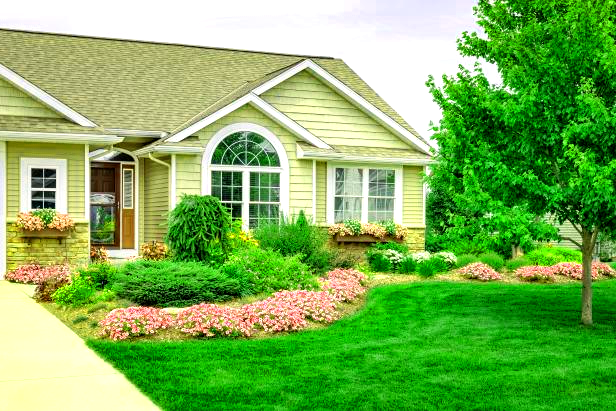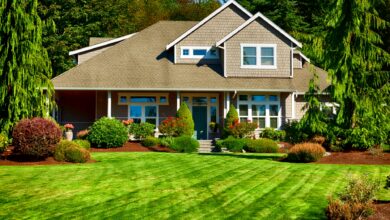10 Low-Maintenance Landscaping Ideas to Makeover Your Yard
Have a gorgeous yard with all the advantages, but none of the effort.

Some people find gardening to be soothing, but for others, it may be a major bother. However, there are many landscaping choices that work well without requiring you to dedicate hours to maintaining the yard.
Farm Worker Job in Canada with Visa Sponsorship 2024 -Apply Online
Low-Maintenance Landscaping Ideas
You may embrace hardscaping aspects and let go of the image of a perfectly maintained lawn, whether you choose low-maintenance native plants and natural growth or remove the greens entirely. These are ten low-maintenance landscaping ideas suggestions from professionals to update your yard and wow your neighbours.
Add rock gardens
Rocks are one of the many non-plant items that may improve the landscaping of a yard. Expanded rock or mulch bed areas are among the most alluring low-maintenance styles that are now in style, according to Bret Douglas, owner of Ironclad Landscape Management and a member of the Thumbtack Pro Advisory Board. According to him, updating your yard with various rock combinations may be both low-maintenance and visually stunning.
Read More : 7 Ways to Refresh Backyard Without Spending a Dime
The best option for year-round durability and curb appeal is a rock garden. Even though the first design features may take some time to complete, rock gardens have low-maintenance plants that are ideal for withstanding weather fluctuations and adjusting to their natural surroundings.
Expand mulch beds
According to Douglas, extending mulch beds is a popular low-maintenance landscaping ideas concept right now. Expanding the mulch areas lowers the need for green lawn.
Furthermore, adding additional maintenance-intensive plants to the mulched area is not essential. Go for a more understated look and leave wider areas of red or brown mulch exposed. Alternatively, include attractive garden accents like feeders, bird baths, or year-round statuary.
Consider ornamental grasses
In 2024, ornamental grasses are going to be huge in gardens. Throughout the year, ornamental grasses are hardy, adaptable, and tenacious plants that radiate low-maintenance landscaping ideas garden beauty.
Consider the Mediterranean. Local plants are drought-tolerant, low-maintenance, and unappealing to deer or rabbits since they are evolved to harsh settings “said Marci Bonner, a landscape architect with Richardson & Associates Landscape in Washington, DC. “Catmint, Russian sage, salvias, lamb’s ear, and ornamental grasses would make a nice combination of textures.” Ornamental grasses are a simple substitute for needy plants if you want to maintain the natural greenery without having to deal with their upkeep.
Embrace hardscaping
Hardscaping is one of the most resilient and fashionable landscaping concepts that doesn’t even include any vegetation. The use of artificial features in yard design is known as hardscaping. Pathways, patios, pergolas, and firepits may all fall under this category.
According to Douglas, there is an increasing need for hardscaping projects, namely those that include decks and concrete paver areas. Less strain is placed on the grass when sitting platforms or pathways are constructed using concrete or pebbled pavement. Therefore, less foot activity is better for the grass, and only infrequent cleaning is required for the concrete surfaces.
Bring in native plants
Locally native plants need less maintenance than foreign plants that aren’t used to the climate and soil. To manage imported plants, it can be easier and more aesthetically pleasing to accept the local environment rather than altering watering schedules and soil hardness.
“A more native approach would result in a harmonious colour palette made up of plants like hollies, coral bells, oakleaf hollies, fothergilla, and switch grass that are native to the area,” advises Bonner. Choose locally native plants that need less upkeep so you may enjoy natural beauty without having to put in as much effort.
Add dry creek beds
Designs for dry stream beds are also growing in popularity. According to Douglas, “people are making use of runoff or washout areas in their landscapes by erecting pathways made of large boulders.”
Lay landscape fabric behind rocks and stones to create a trail that resembles a stream. Then, to improve the charm of the landscape, line it with different plants and driftwood. He continues, “The water cascading through these dry creek beds looks particularly striking when it rains or when there is heavy runoff.” Year-round drainage is improved by dry stream beds.
Use ground cover
Plant creeping and low-lying plants as ground cover to maintain a lush, green landscape without having to do all the work. The blooming plants that provide greens in wooded areas include phlox, evening primrose, and lily of the valley. Don’t worry, these evergreen plants can even withstand some shade.
These plants inhibit invasive weeds, preserve the soil, and retain moisture. Ground cover plants provide a mysterious appearance and pleasant scent to your landscape. They are also quite adaptable.
Incorporate stonework
Stepping stones provide a much-needed update for your yard. Homeowners like hardscaped spaces because they need less upkeep once established, according to Douglas. These durable components may run for years or even decades before needing to be replaced. Stone paths are rather easy to build, except from the initial cost of purchasing the stone design of your choosing.
Add wooden areas
Common patio features that save yard upkeep include wooden decks and stairs. Whether you decide to upgrade your porches with wood-plastic composite materials or construct a wooden extension to your house, long-lasting and weatherproof low-maintenance landscaping ideas solutions may make your outdoor areas seem better.
Read More : How to Clean Granite Countertops 2024
Try meadowscaping
A distinctive and fashionable yard design is meadowscaping, which turns any common garden into a true home for the flora and fauna that would typically graze these biodiverse areas.
A gardening method called meadowscaping helps to restore well-manicured lawns to a more natural condition. The objective is to turn rural areas into meadows and allow native vegetation to proliferate. It implies more lush grasses and colourful bursts combined with a controlled chaos reminiscent of the natural world. Plants may, of course, be pruned back if they start to take over more livable sections of the yard. Because meadowscaping simply has to be mowed and sprinkled occasionally, it takes little upkeep.
Be careful to observe any municipal regulations about the height of grass and welcome any insects, birds, and plants that used to flourish on that soil.











